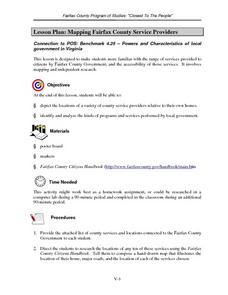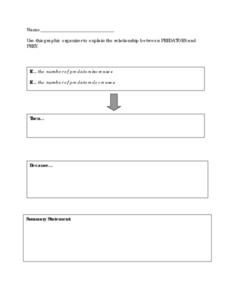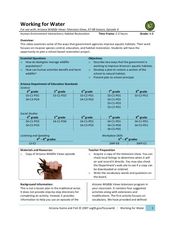Curated OER
Hunters and Gatherers
Sixth graders participate in mapping and other activities to understand why ancient civilizations developed as they did. For this ancient civilization lesson, 6th graders recognize that there were three important climate zones and...
Curated OER
Lessons for Beginner Atlatl Users
Ninth graders research weapons of the Aboriginal people and throw a dart with and without the use of an atlatl. In this cross curricular lesson, 9th graders research the weapons of the Aboriginal people. They throw darts with and without...
Curated OER
Biomes: Land of the Inuit
Students study Inuit and their ancestors. In this biomes lesson students study the relationship between the Inuit and their environment and create a class art gallery.
Curated OER
Oodles of Poodles
Young scholars solve equations by graphing. In this algebra lesson, students differentiate between functions and relations. They use the TI to graph their equation and analyze the graph.
Curated OER
Explore Your Natural Habitat
Students identify habitats and understand why they are important to our environment. For this environmental lesson students design their own habitat, observe and record data on the impact their habitat has on the environment.
Curated OER
Technology of the Ancient World Lesson Plans
Technology of the ancient world lesson plans can open students' eyes to the influence of early innovations.
Curated OER
Mapping Fairfax County Service Providers
Students brainstorm a list of services governments should have available to its citizens. Using the internet, they locate as many of these services as possible and compile a class list. They also analyze specific programs to consider...
Curated OER
Outdoor Survival
Learners are introduced to basic outdoor survival concepts. They identify the seven basic needs for survival. Students describe the symptoms and treatment for frostbite and hypothermia. They compare and contrast the value of different...
Curated OER
Predators and Prey
Pupils explain how the food chain works. They contrast predators with prey and describe their function in nature. Students discuss how the food chain aids in keeping nature balanced. In small groups, they play a game that simulates the...
Curated OER
The Conscription Crises
Students explore roles played by Canada's prime ministers The Right Honorable Sir Wilfrid Laurier and The Right Honorable iam Lyon Mackenzie King with regards to the conscription crises of World War I and World War II.
Curated OER
Home Sweet Home
Students examine the animals that live in trees. They identify their sounds, footprints and droppings. They draw pictures of the animals as well.
Curated OER
Wacky Water Critters
Students visit a local creek or stream. They collect water samples from the creek and observe and sort the "water critters" they find in the sample, observing smaller organisms under a microscope if necessary. They identify each organism...
Curated OER
Critter Encounter Chart
Students record data found at an assigned web site. In this data collection lesson, students access an assigned web site in order to complete a data chart about animals they see. They travel to different sections of the web site to find...
Curated OER
Working for Water
Learners examine the ways that government works to help improve aquatic habitats. In this water habitats lesson students view a video and plan a school restoration project.
Curated OER
Vocabulary: Kansas Prairies
Students explore the ecosystem by reviewing scientific vocabulary terms. In this environmental awareness lesson, students identify the differences between abiotic and biotic factors and their relationship to the Earth. Students define...
Curated OER
Rock-a-bye Babies in a Wetland
Students review the way human babies grow and what type of care they need. Using the internet, they are introduced to five different wetland habitat animals and how their babies grow. They discover how they are born and what the...
Curated OER
More Than a Campground
Fourth graders participate in a class disucssion on the term "habitat". The class brainstorms on what makes a national park special. In small groups, they research a a national park and create a mural depicting those factors that make...
Curated OER
Marine & Aquatic Habitats Activities - Habitats of Birds, Fish, and Mammals on the Island and the Pacific Region
Students create habitats in jars to understand integral aspects of plants' and animals' habitats.
Curated OER
Evergreens In Winter
In this identifying trees worksheet, students learn to identify 8 winter trees by their shapes. Students cut out flashcards with the name of the tree and its shape in silhouette.
Curated OER
Enrichment Activities - "Mrs. Frisby and the Rats of NIMH"
Fifth graders read the novel "Mrs. Frisby and the Rats of NIMH." They discuss the various characters in the book, and the different types of conflict that take place within the book. They also research owls and rats to make comparisons...
Curated OER
Companion Animals
For this animals worksheet, students discuss their own pets. Then students answer 3 questions having to do with pets and overpopulation. Students then separate into debate teams and debate licensing and breeding issues.
Curated OER
A Natural Habitat: What, How and Why
Students understand what a habitat is. They determine why a habitat is important to our environment no matter where it is located. Students observe and recognize natural habitats in their surroundings.
Curated OER
Food Webs
Students recognize interdependence in a food web by using yarn and notecards to create a food web and discussing what would happen if one of the organisms from a certain trophic level is removed.
Curated OER
Prairies
Students identify the basic characteristics of the prairie ecosystem, and several commonly known prairie species. They create a classroom mural of a prairie ecosystem; and create reports about what they have found out.
Other popular searches
- Animal Shelter Mystery
- Domestic Animal Shelter
- Animal Shelter Objectives
- Animal Shelter Plans
- Animal Shelter Lesson Plans
- Animal Shelter Service Project
- Animal Shelter Nesting
- The Animal Shelter
- Animal Shelter, Nesting
- The Animal Shelter Mystery
- Animal Shelter\, Nesting

























